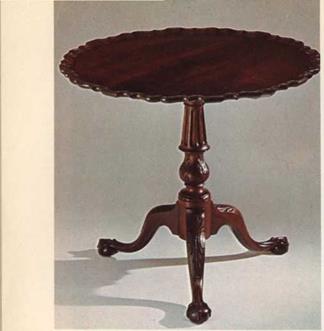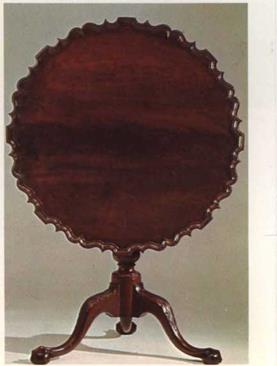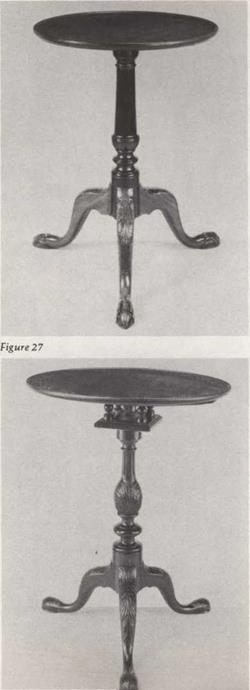 closely related to Figure 34, but in neither example is the carving in the high relief that is associated with tilt-top tables made in Philadelphia (Figs. 11518). According to Joseph Downs, this table was found in Albany. In the advertisement of the sale of household furniture noted above, "A Sett of fine Tea Table China" was also to be sold, indicating clearly the purpose of these handsome tables.6 PI. IV: mahogany, cherry; 1765-75; H 28V*~ (71.7 cm), Diam 3VM"
closely related to Figure 34, but in neither example is the carving in the high relief that is associated with tilt-top tables made in Philadelphia (Figs. 11518). According to Joseph Downs, this table was found in Albany. In the advertisement of the sale of household furniture noted above, "A Sett of fine Tea Table China" was also to be sold, indicating clearly the purpose of these handsome tables.6 PI. IV: mahogany, cherry; 1765-75; H 28V*~ (71.7 cm), Diam 3VM"
(81.6 cm); асе. no. C59.2928.

Plate IV. Tea Table. "A round Mahogany Pillar, and Claw Table" offered for sale in New York City in 1763 is a succinct description that might apply to Plate IV. If the term scallopt (scalloped) had been added for the piecrust edge of this tea table, no doubt would exist about its application. Leaf carving on the knee and vase-shaped baluster, a fluted pillar or column, and typical New York tripod-base claw feet, leave little doubt of the table’s origin. It is
Figure25. Tilt-Top Candlestand. Candlestands were the result of wood turning and joinery.
Whether city cabinetmakers always purchased parts from turners for assembly on tripod bases or sometimes turned and shaped all the necessary parts, as did country craftsmen like Nathaniel Dominy V of East Hampton, N. Y., is not known. Less expensive than tables, they held not only candlesticks but a variety of ceramic and metal objects. In this period, the piecrust edge so highly prized today (Fig. 25a) was referred to as scallopt. The feet and legs of this stand are closely related to a tripod-base tea table made for Robert Sanders of Albany.” Fig. 25: mahogany: 1760-80; H 28" (71.7 cm); Diam 24" (61 cm); acc. no. G65.2904.
37




